Going Global
The Politics of Interruption
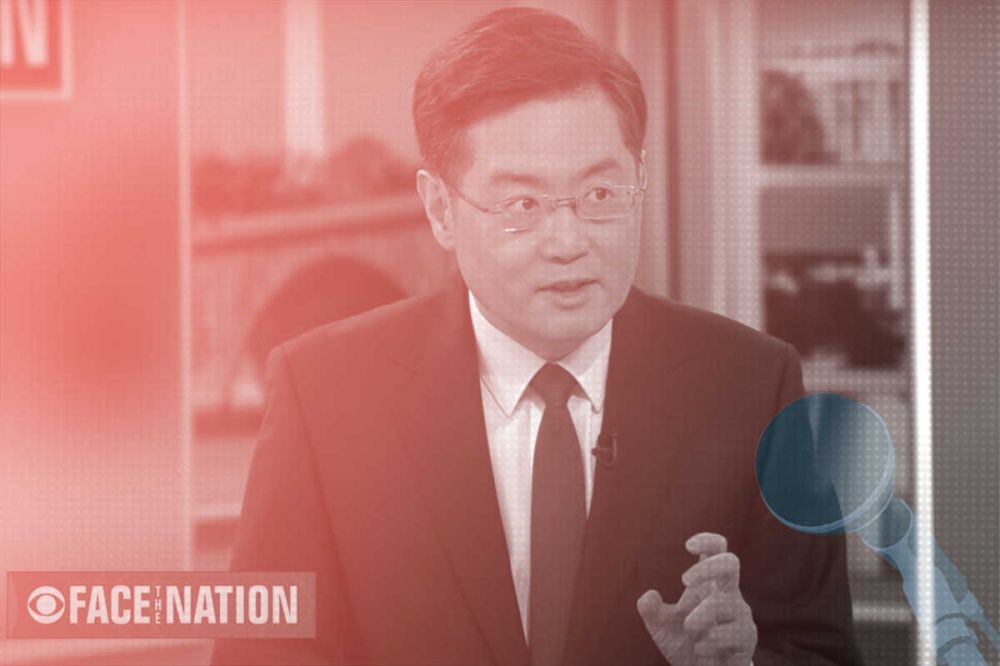
This week “News Report Frontline” (新闻一线), an audio program produced by The Beijing News, brought together a state media program host and a communications scholar to discuss respect and professionalism in the context of the television news interview. The program’s news hook was an interview back in March with China’s ambassador to the United States, Qin Gang (秦刚), who spoke for nine somewhat testy minutes with Margaret Brennan, the host of CBS’ “Face the Nation,” about China’s position on the war in Ukraine.
Far from clarifying standards of journalistic professionalism, the discussion at “News Report Frontline” was the culmination of the month-long amplification of a misleading news frame, and a textbook lesson in how China’s state-run media have sought to deflect core questions about China and its position on the Ukraine war.
“Let Me Continue”
The Qin-Brennan interview, which aired on March 20, 2022, dealt with several basic questions. Does China intend to provide material or policy support to Russia? Why hasn’t China been clear in condemning the invasion? Does China actually intend to exert its influence on Russia for the sake of peace – given its insistence that its “trust relations” (as Qin calls them) place its government in a “unique position” (also Qin’s words)?
Brennan was hard-nosed and insistent throughout the interview, and at times there was the gleam of impatience in her eyes. But she was never, by any reasonable journalistic standard, unprofessional. She fought to keep the interview flowing with an Ambassador Qin who often spoke with a molasses ooze as he stuck to official Chinese talking points. He was an interviewee who needed prodding, and who certainly needed challenging.
For his part, Qin managed to push through tension that cut both ways. At one point, after he pointed to peace talks as evidence of progress, and as Brennan was on point of interjecting, he managed to head her off, saying, “Let me continue.” He plodded on with another point about China’s “trusted relations with Russia” being an asset, making the assertion that China is “part of the solution.” This was a reasonable point for Brennan to cut in, and she did so with a follow-up: “So are you saying, though, just so we’re clear, are you saying Beijing will not provide financial support to Moscow to prolong this war?”
Counting on Western Media Bias
But viewed through the lens of China’s state media, the exchange on “Face the Nation” was never about the issues. Within hours of the interview’s release, the dominant frame centered on Margaret Brennan’s appalling manners – her deficient suzhi (素质), or the sum of her attitude and ideas as evinced in her conduct. And the evidence of her deficiency was the appalling number of times that she had dared to interrupt the ambassador: 23 times in just 9 minutes.
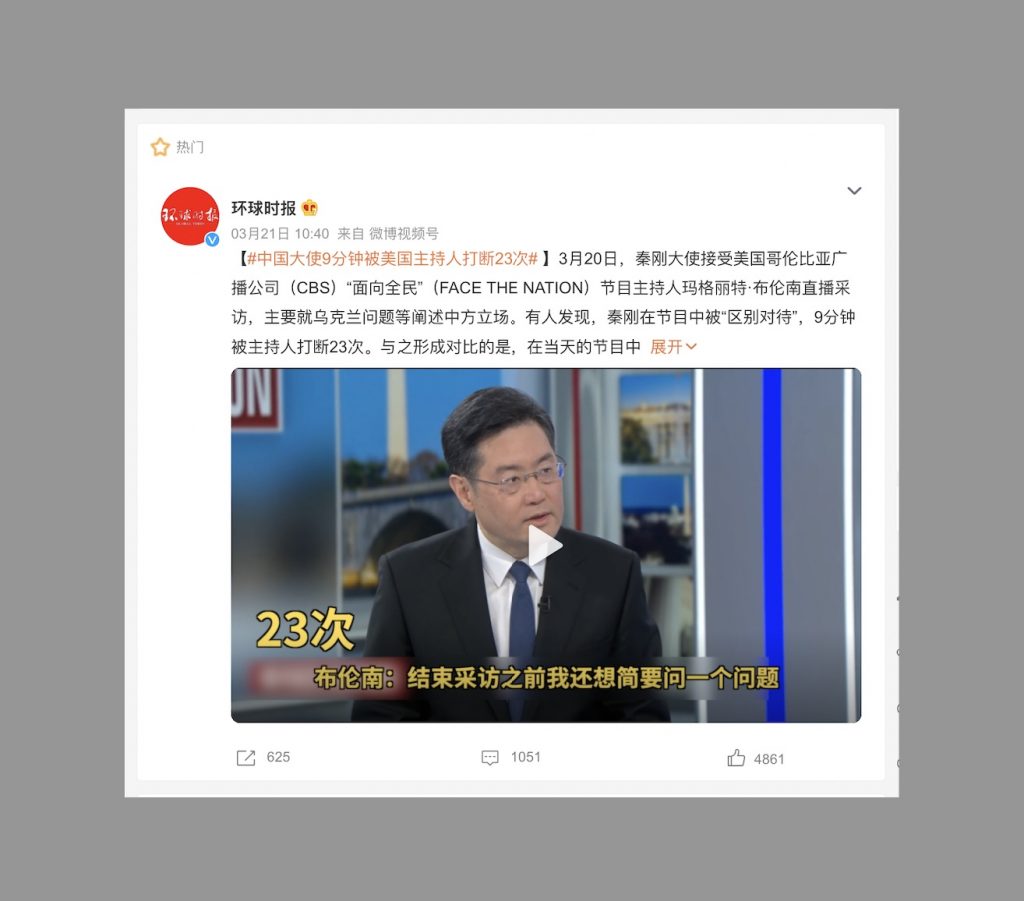
As word of the “Face the Nation” interview proliferated across Chinese social media platforms, 9/23 was far and away the dominant meme. In the way that all numbers are magical in the world of CCP propaganda – so that the sheer number of websites can be laid down as proof that expression is free – the number 23 spoke its own truth. 9 minutes divided by 23 interruptions equals 1 indignity every 39 seconds. How, then, could Brennan’s interview not be a national insult, and proof positive that the Western media are a crucible of lies?
A search for the phrase “Interrupted 23 times” (打断23次) on Weibo turns up numerous March posts from Chinese state media accounts that allege unprofessionalism on the part of the Brennan. There is also a dedicated hashtag to the topic, generated by the Global Times, that calls up related posts by a wide array of state media outlets and official accounts from Party-state organs: Global Times, China Daily, the Liaoning Chapter of the Chinese Communist Youth League, Shanghai Media Group, CGTN Radio, Huashang Daily (Shaanxi province), and so on.
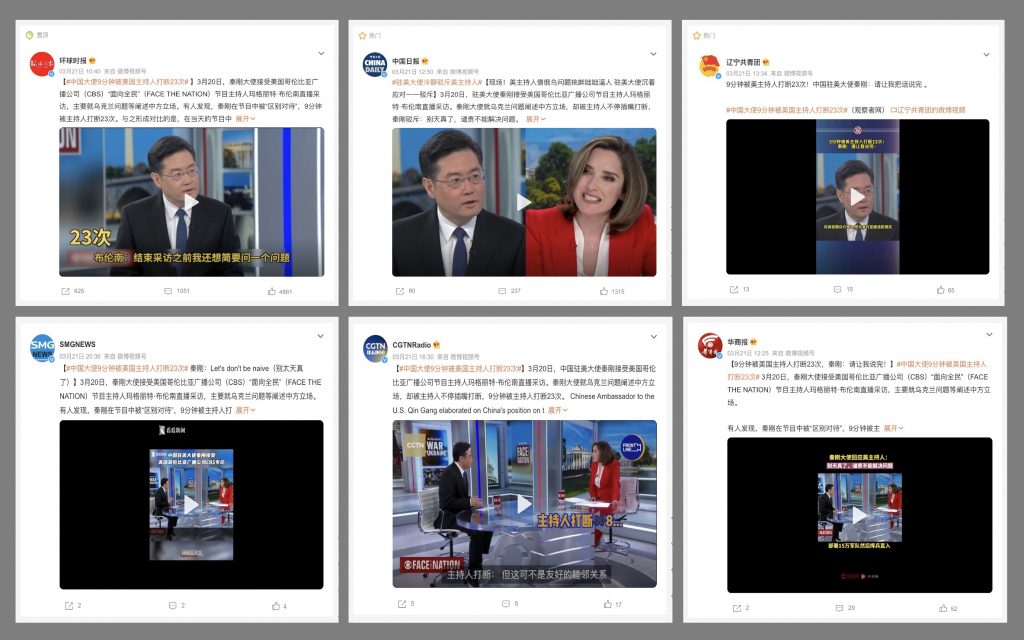
Of the scores of official social media accounts posting about the Brennan interview, which included several edited versions with interruption counts, the number was always 23. No one counted 21, 22 or 24 interruptions.
Dominant across most social media channels was the video version produced by the Global Times, shortened to interrupt the flow and enhance the sense of interruption by Brennan. As the official Weibo account of the Global Times shared the interview on March 21, Brennan’s 23 interruptions were right up front:
Qin Gang was interrupted 23 times in 9 minutes. Chinese Ambassador to the U.S. Qin Gang was interviewed live on CBS’s “Face the Nation” program on March 20, introducing to American audiences the situation of the Sino-US summit call on March 18, and elaborating on the most important issue for American people: China’s position on the Ukraine issue.
The video included with the Global Times post accentuated the points of supposed interruption, with bright yellow characters popping up on the screen to indicate “first interruption,” “second interruption” and so on.
In the Global Times post and other posts from state media, the overall frame was crystal clear: Brennan’s inexcusable conduct was yet another illustration of the arrogance, bias and prejudice of US and Western media, and evidence of a conspiracy to criticize China and shift the blame on Ukraine.
A post to the official Weibo account of Shanghai’s Xinmin Weekly began: “Qin Gang is ‘treated differently’ as a guest on top American program, interrupted 23 times in 9 minutes!” When, more than two weeks later, the official account of the international news desk at Xinhua News Agency shared the story again, it was as part of a series of commentaries on the theme, “Total shamelessness in cheering for US hegemony” (为美国霸权摇旗呐喊毫无操守).
But what if we poke at the foundations of this imposing tower of coverage on a simple point of hyper-sensitivity? Were these interruptions actually interruptions?
Keeping Score for the State Agenda
View the Brennan interview without these guiding labels and framing and most of the supposed interruptions cited by the Global Times and other state media are contestable. The first two interruptions are clearly interjections, neither of which interrupt the flow of Qin’s speech – unless one simply assumes he has a right to speak without interdiction or direction from the program host.
The first “interruption” comes as Qin says: “We are promoting peace talks and we are sending humanitarian assistance.” Speaking with laborious slowness, Qin is perhaps on the cusp of making a further remark. Instead, Brennan interjects: “Will you send money and weapons to Russia, though?”
Does this constitute an interruption? Is it unprofessional?
On the first question, Qin has already made a complete point, that China has provided humanitarian assistance. It is a highly subjective reading to view Brennan’s relevant follow-up question, in the midst of what seems a natural pause during a short interview on a heated issue, as an interruption. On the second point, is it not wholly appropriate for Brennan to seek clarification on what is after all the key point of the interview, whether or not China has directly or indirectly supported Russia’s aggression against Ukraine?
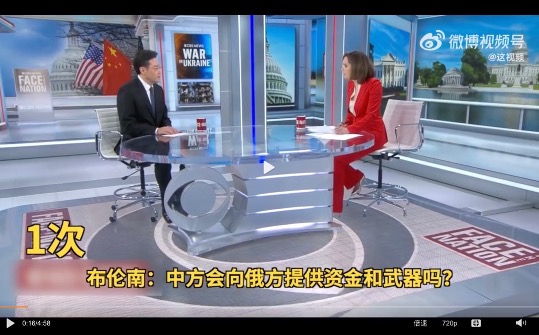
The second “interruption” occurs as Qin alleges disinformation about whether China has provided military assistance to Russia. “We reject that,” he says. Brennan begins again to interject. But once again, Qin has made a complete point here, on which the host understandably seeks clarification. “You won’t do so, Beijing will not?” she asks. But we are dealing with magical numbers, and with hyper-sensitive nerves, and so the damning count pops up on the video once again: “Two interruptions.”
And what about the rest of the dialogue?
Viewing the entire interview as posted to the “Face the Nation” YouTube channel, I counted 27 points in the interview on which the question of interruption might possibly arise – according, mind you, to the absolute lowest bar. I invited myself to such heights of hypersensitivity that even points at which Brennan can be heard saying, “Mm hmm,” as though urging Qin along, were included in my list. Reviewing the list, I then sought to determine which points might be identified clearly as interruptions, meaning that Qin was unable to complete a thought or to plow ahead through the host’s attempt at interjection (a natural occurrence, as any conversationalist knows). This unscientific assessment of an entirely subjective question identified just four genuine interruptions. These were not, mind you, examples of unforgivable rudeness or unprofessionalism. They were simply points where Brennan, leaving justification aside, did seem to effectively cut Qin off – such as the point at the end where Brennan cuts Qin off because they are frankly out of time.
One of the most telling instances comes just before the eight-minute mark, as Qin belabors the point that China’s engagement with Russia has put it in a unique position as a potential peacemaker. “So China’s unique role, you know,” he starts and stops, “[can] help the peaceful settlement of the crisis.” He pauses and seems about to go on, when Brennan pipes up: “Tell me then – because I keep hearing you say that. I want to understand how China is helping.”
This question from Brennan, responding directly to Qin’s assertion that China has a “unique role,” makes perfect sense. She is asking for something concrete beyond the government talking point. But this single moment is logged by Chinese state media as interruption 19 and 20 of the interview.
Global Interruptions
Looking more closely at how the 9/23 Brennan frame was shared across Chinese social media, and by which accounts, its role as a state-driven effort to pull focus from criticism of China becomes clear.
According to one early post on the official Weibo account of the CCP’s Reference News (参考消息), the 23 interruptions in the Brennan interview were first spotted by a “Chinese internet user.” It could possibly be that an unacknowledged user somewhere in cyberspace originated the 23 interruptions meme, but it’s clear that the first post to elevate the frame originated with Wang Bingru (王冰汝), the correspondent based in Washington, D.C., for the partly state-held Phoenix TV, which in recent years has been more closely aligned with state agendas. Earlier this month, Phoenix was forced to close its network office in Taiwan, authorities having designated it “a de facto Chinese state-controlled entity.”
Wang is a massive influencer with close to four million followers. Posting the “Face the Nation” video, Wang added the title: “Qin Gang is ‘treated differently’ as a guest on top American program, interrupted 23 times in 9 minutes!” Shared 3.5 million times on Weibo alone, Wang’s video was showered with bullet comments from users, many wasting no time in making explicit the main theme that would soon be amplified by the above-mentioned range of state media accounts. Bottom line: This was yet another case of Western media bias and unprofessionalism, with implications for the state and all of its subjects.
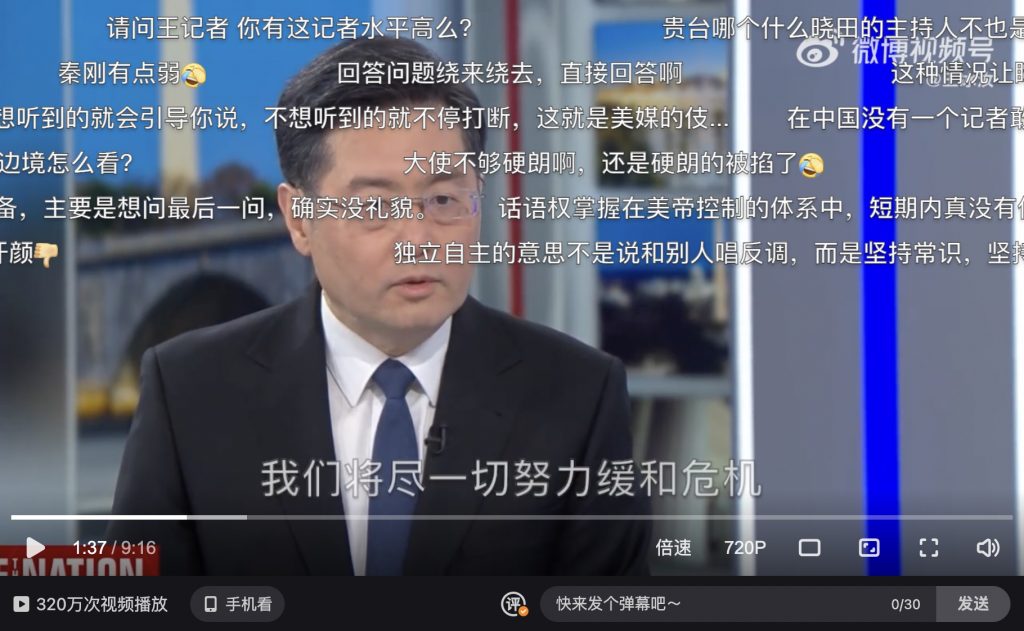
“Discourse power is grasped in the hands of the system controlled by the American imperialists,” said one comment. Another grew vicious with an epithet, “whore-espondent” (妓者), that has often been directed at journalists online in China: “[She] doesn’t want to listen and constantly interrupts, exactly like a ‘whore-espondent’ for American media!”
Other comments on Wang’s video were more skeptical. “So, Journalist Wang, are you more skilled than this journalist?” one asked. “The ambassador isn’t smooth enough,” said another. Referring to Fu Xiaotian (傅晓田), a Phoenix TV host who has interviewed diplomats and world leaders (and would interview Qin four days later), another comment ventured: “Isn’t that Xiaotian host at your network also known to interrupt her interviewees all the time?”
But the interruption theme nevertheless went viral, pushed by apps and social media posts from Party-state media, even as official news releases on state-run websites and traditional media remained more even-handed in presenting the interview. (The Chinese Embassy in the US posted a Chinese-language version of the transcript without any indication of interruptions.)
One of the earliest posts recorded on Weibo was made at 8:29AM Beijing time on March 21, shortly after the “Face the Nation” episode aired in the US and the Wang Bingru video post was made. That post came from “Kunming Luquan Release” (昆明禄劝发布), an official account operated by the local CCP propaganda department in the county of Luquan in Yunnan province. “Qin Gang’s full interview with CBS. In 9 minutes he was interrupted no less than 23 times, but was still able to maintain a polite and friendly smile,” it read.

The vast majority of posts from the social media accounts of Chinese state media followed over the next 4-6 hours, including the Global Times, the official China News Service, China Daily, Xiamen Daily, International Finance News (under the People’s Daily), and Hong Kong’s CCP-linked Ta Kung Pao. Commercial or hybrid media outlets like Shanghai’s Guancha Syndicate and Netease Finance also followed up on the story, all repeating the 23 interruptions meme. Many more outlets, like Taihainet.com, a news portal under the official Fujian Daily, shared posts from outlets such as the Global Times.
One of the most popular video versions, set to dramatic music and gaining nearly one million views, was produced by a media outlet called “Haike News” (海客新闻). It was this version that was used by China Daily on the morning of March 21. A search for “Haike News,” which has its own YouTube channel that claims to be operated from Taiwan, is in fact a product of the overseas edition of the CCP’s official People’s Daily. This is clearly stated on the “Haike News” Weibo account, linked to the YouTube channel, as well as links to app downloads.
The “Haike News” app is listed in open-source materials as a product of Haiwainet Media Company Ltd. (海外网传媒有限公司), which operates haiwainet.cn, “the official website of the overseas edition of the People’s Daily.” A search of company records confirms that Haiwainet Media Company Ltd. is jointly owned by the People’s Daily newspaper (人民日报社), which holds 40 percent, and the Shanghai-listed People’s Daily Online (人民网股份有限公司), which holds 60 percent.
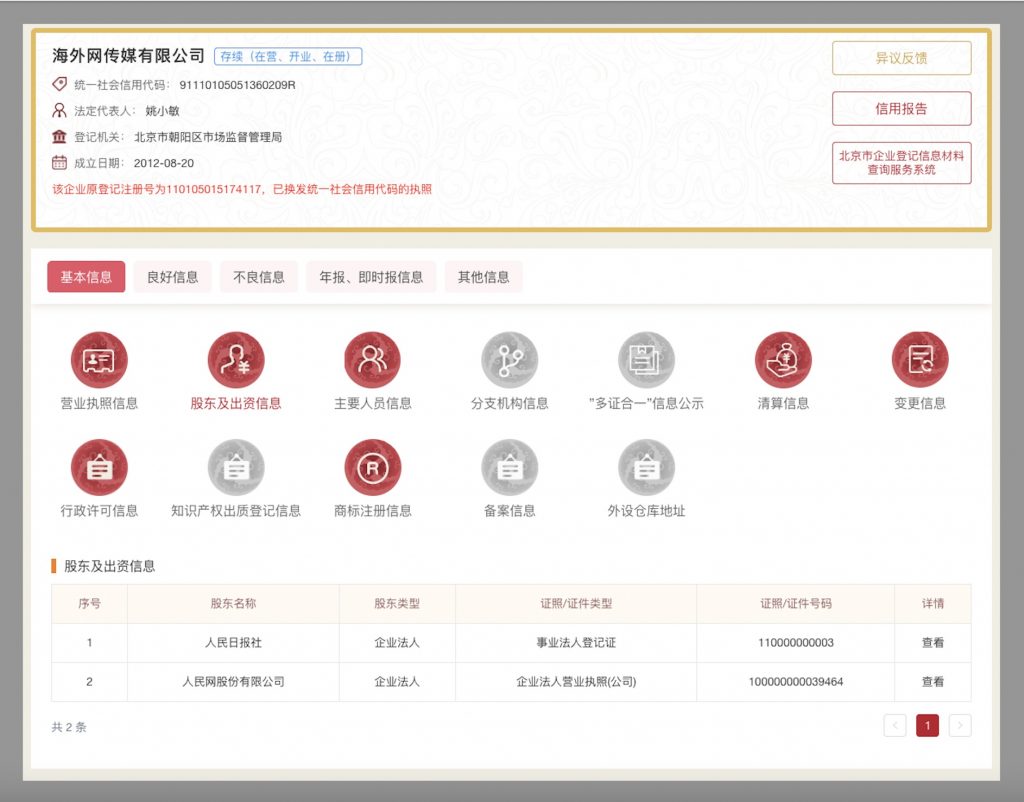
One of the most active outlets pushing the interruption meme was the Global Times, another spin-off of the CCP’s official People’s Daily, which addressed the story in both English and Chinese on its website, as well as through numerous social media channels. The Global Times also covered Brennan’s supposed interruptions in a second English-language report called: “Netizens call out ‘rude’ CBS news host for heckling Chinese envoy.”
Is it any surprise that netizens called out Brennan? After all, they were exposed to this very directed meme – never questioned from the moment Wang Bingru suggested it – through a vast network of social media posts and channels. But when this cacophony is traced back to its source, we are left with a handful of Party-state media that, like “Haike News,” trace quickly back to the center.
The People’s Daily, the Global Times, People’s Daily Online, Haiwainet.cn, “Haike News” – all of these media outlets and their social media accounts are ultimately linked to the CCP’s Central Propaganda Department, which is the People’s Daily’s sponsoring body. And when we look at other players in the bad-suzhi Brennan story, they are almost uniformly either linked Party-state media themselves, or the social media accounts run by local offices and departments within the vast Party-state system – accounts like the above-mentioned “Kunming Luquan Release.”
China Daily, the official English-language publication of the Information Office of the State Council, may seem to be on the government as opposed to the Party side of this equation (an academic distinction). But the equation still balances the same way. The newspaper’s supervising institution is listed in company documents as the “Central Group for External Propaganda” (中央对外宣传小组), the same entity as the “Central Office for External Propaganda” (中央对外宣传办公室), which is directly under the Central Committee of the CCP.
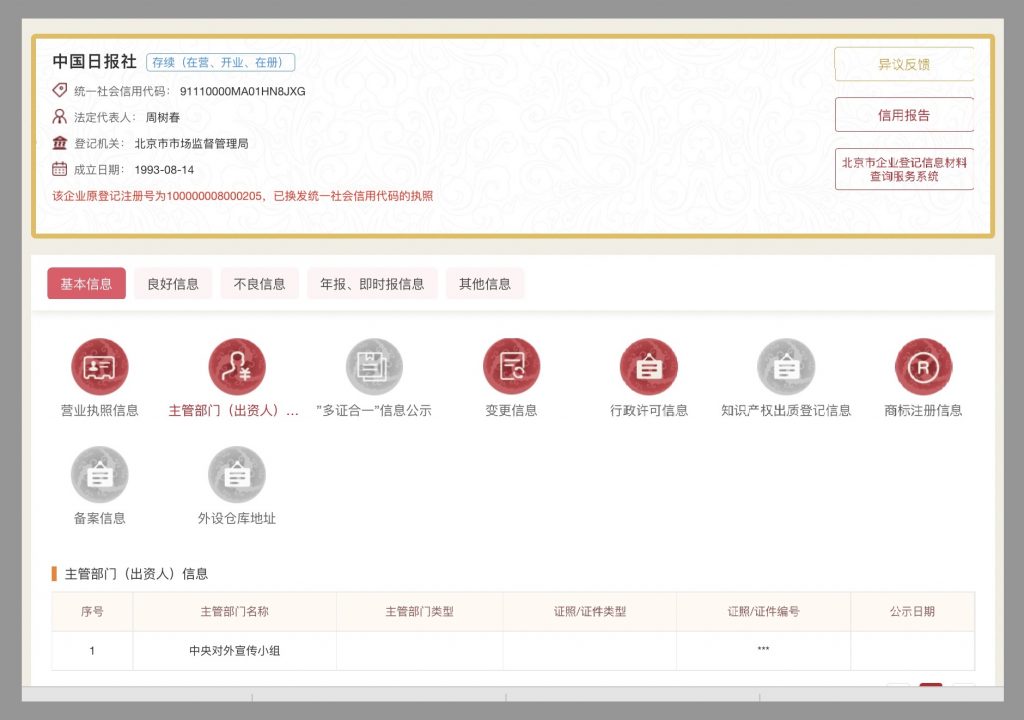
The upshot here is that a meme we are supposed to believe was genuinely popular, a reflection of genuine Chinese public chagrin at a real act of contempt by a Western journalist, was manufactured through a broad network of social media accounts and websites all emanating from the power center of the CCP.
This is just one of many hundreds of memes that the Party’s developing viral propaganda network has disseminated in recent weeks, and there are surely many thousands yet to come. But it offers a sense of what Xi Jinping meant in December 2015 when he likened the transformation of the CCP’s media and propaganda system to a vast creature reaching out to every node of attention. “Wherever the readers are, wherever the viewers are, that is where propaganda reports must extend their tentacles, and that is where we find the focal point and end point of propaganda and ideology work,” he said.
This Party-state network of meme generators and disseminators is a part of the larger process of the Party’s “media convergence” (see CMP’s related piece this week), which seeks to leverage “emerging media” to create more effective propaganda and “guidance,” recognizing that this can only happen if new platforms effectively “follow the laws of news dissemination and the development principles of emerging media.”
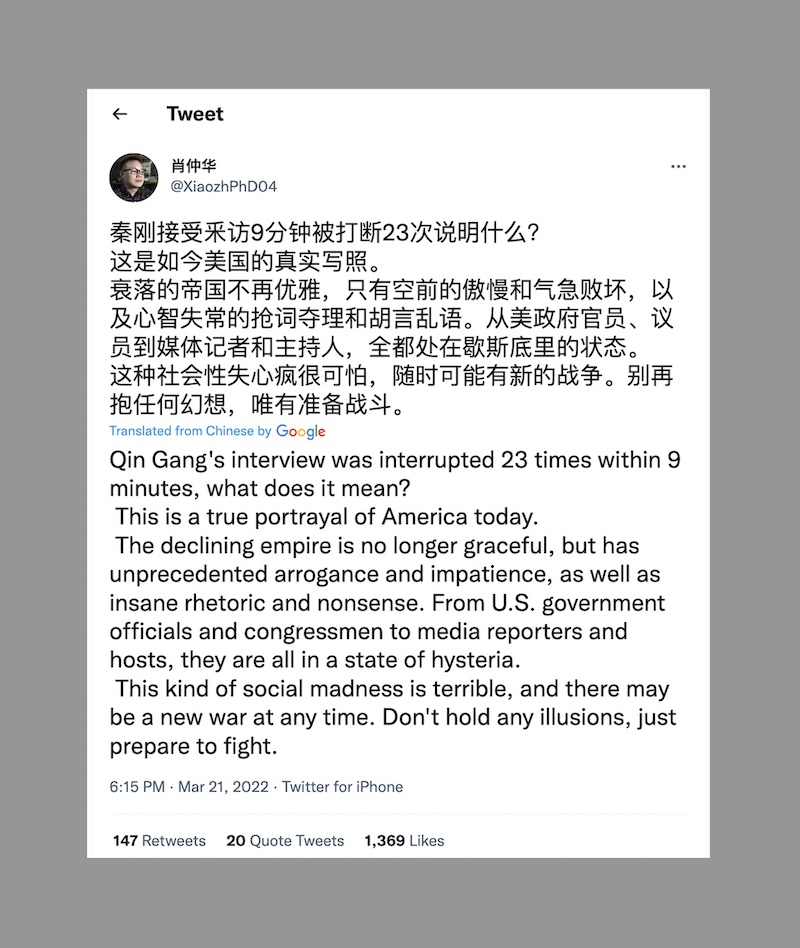
This system also responds to the progressive collapse of the distinction between internal and external propaganda. Memes like that focusing on the Qin-Brennan interview, while amplified domestically to divert, distract and undermine criticism of the state, also serve as disinformation that can be amplified through external channels, including Western social media platforms.
The Story Behind the (Manufactured) Story
This week, as “News Report Frontline” turned with seriousness to the question of Margaret Brennan’s journalistic transgressions, the time was long past for asking basic questions about the soundness of this frame. By this point the 9/23 formula had circulated for a full month. The story, which “News Report Frontline” promised to unpack – the program’s tagline is “exploring the story behind the story” – was pre-loaded with conclusions inflating Brennan’s singular professional approach as a Western hegemonic conspiracy.
The show’s guest experts, including Cao Peixin (曹培鑫), a professor and deputy director at the School of Journalism at Communication University of China (CUC), and Li Jingjing (李菁菁), a news host at the state-run CGTN, obligingly ran in their tracks. Aired exactly one month after the meme went bonkers, the program was called: “Interrupting Qin Gang 23 Times in 9 Minutes: Where Exactly Was the Female Host in the Wrong?”

“News Report Frontline” began with this oddly imbalanced pair of questions:
What techniques did the host use during the interview program? In a situation in which Europe, the US and developed countries monopolize discourse power, how should workers in international communication raise their communication capacity?
The plunge between these questions is dizzying, but a nearly perfect mimicking of the great leap required of the audience. The question about technique might invite a more critical look at Brennan’s exchange with Qin, and a substantive discussion of ethics in the interview process based on shared standards of professional journalism. But that never happens.
The second question is the super-frame that drowns out all other considerations. Clearly, Brennan’s tough questioning of Qin must be seen as an example of the Western bias stemming from China’s relative weakness in terms of “discourse power.” The absurdity is entirely lost on the participants, who are deep in the game — namely, that a meme entirely manufactured by an array of media outlets and accounts devoted to external propaganda has become the focus of a discussion about the urgency of external propaganda (state communication, if you like) in mobilizing against the West.
Cao Peixin speaks of the challenge of “an unequal communication order,” in which “the mainstream media of developed countries, because they have greater discourse power, can determine history and the facts.” For Li Jingjing too this is an us-versus-them battle in which Chinese must defend themselves, which is to say – remembering that we are talking about a Chinese diplomat – that Chinese must defend the state.
Western countries’ suppression of China overall will permeate down to the individual level. Working in this field [of journalism], we should understand that Western media often label China while ignoring our behavior. Young people must have their own critical thinking, their own attitudes and the ability to distinguish right from wrong when others judge us. We also need to be bold enough to stand up and speak out, improving our ability to express ourselves, and not letting others define us.
The conflation in Li’s words of the self and the state is precisely what the Brennan meme was meant to achieve in the first place. If the meme works its magic, those 23 interruptions in just 9 minutes will be felt intimately, by each Chinese person, as an insult against their personal dignity. And this personal animus toward the interviewer, who in this mini-drama represents the antagonist that is the West, can then congeal into shared national pique.
From the perspective of the propagandist, the wonderful thing about shared pique is that it deadens the mind and simplifies the story. In a fragmented information world, it gives a piece of content, however ludicrous, virality.
For “News Report Frontline” the story behind the Brennan interview is ultimately, then, about China’s fury at suffering a perceived interruption. It is about China’s loss of voice. That story is of course familiar to those who study China’s external communication policies. It is the story, Xi Jinping’s story, that undergirds the global telling of the “China story” and its roots in the glories of the CCP. On the path to a “great rejuvenation,” the Chinese people must not be interrupted. And no one needs to ask who will speak for them.






















